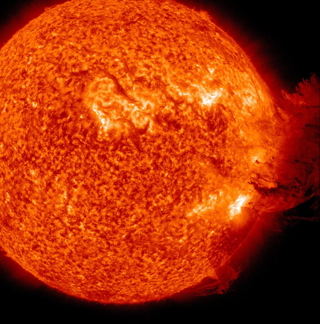 Science
Science
 Astronomy
Astronomy
 Solar Flares & Sun Spots
Solar Flares & Sun Spots
Don's Home
 Science
Science
 Astronomy
Astronomy
 Solar Flares & Sun Spots Solar Flares & Sun Spots
|

Sunspots are localized regions of extremely intense magnetic fields. These magnetic fields intertwine, and the resulting magnetic energy can generate a sudden, violent release of energy called a solar flare or coronal mass ejections (CMEs).
There is often confusion about the difference between solar flares and coronal mass ejections (CMEs).
A solar flare is an explosion on the Sun that happens when energy stored in twisted magnetic fields (usually above sunspots) is suddenly released. Flares produce a burst of radiation across the electromagnetic spectrum, from radio waves to x-rays and gamma-rays. Coronal Mass Ejections (CME) CMEs travel outward from the Sun typically at speeds of about 300 kilometers per second, but can be as slow as 100 kilometers per second or faster than 3000 kilometers per second. The fastest CMEs erupt from large sunspot active regions, powered by the strongest magnetic field concentrations on the Sun. These fast CMEs can reach Earth in as little as 14--17 hours. A flare is called a coronal mass ejection (CME), an expanding bubble of charged particles that race outward. Flares release energy in many forms - electro-magnetic (Gamma rays and X-rays), energetic particles (protons and electrons), and mass flows. It arrives at earth 18-36 hrs. after leaving the sun. Light and other radiation travels from the Sun to Earth in about 8 minutes. The Solar and Heliospheric Observatory (SOHO) coronagraphs captured this movie of a coronal mass ejection heading toward Earth on Oct. 22nd 2003.
Categories: There are several rating systems and I don't understand all the relationships.
Astronomers rank solar flares into five categories according to the extent to which they emit X-rays. Class X is the most powerful, being tens times the intensity of G-scale M-class flares.
Kp-index:BR>
A scale that ranges from 0 to 9, with 5 or higher indicating a geomagnetic storm. The Kp-index is derived from the maximum fluctuations of horizontal components observed on a magnetometer during a three-hour interval.
G-scale:
What is the M scale Cycle: The sun has an average 11-year cycle of behavior which is projected to peak in 2013. One on March 6, 1989 knocked out power to the Canadian province of Quebec. In 1997, an AT&T Telestar 401 satellite used to broadcast television shows from networks to local affiliates was knocked out during a solar storm. In May 1998 a solar blast disabled PanAmSat's Galaxy IV. Among the casualties: automated teller machines; gas station credit card handling services; 80 percent of all pagers in the United States; news wire service feeds; CNN's airport network; and some airline weather tracking services. A space storm also heats the upper level of Earth's atmosphere, causing it to expand. That's no good for satellites that can get caught up in air that didn't used to be there. Communication disruptions can occur without actually damaging satellites. Even cell phone towers can be zapped, causing dropped calls. The greatest solar storm on record (prior to the Nov. 2003 storm) occurred in 1859, shorting out telegraph wires and starting fires in the United States and Europe. Paal Brekke, SOHO deputy project scientist, told SPACE.com this week's storm, if it hooks up with Earth in just the right way, would be about one-third as strong as the 1859 tempest. The magnetic orientation of the CME relative to the Earth's magnetic field affects the intensity of the flare.
Flares are characterized by their brightness in X-rays (X-Ray flux), the GEOS Class. The biggest flares are X-Class flares. They are major events that can trigger radio blackouts around the whole world and long-lasting radiation storms in the upper atmosphere. Strength is also determined by magnetic field strength of the solar wind measured in nT (nano-Teslas)
Oriented Scintillation Spectrometer Experiment (OSSE) Solar Flare Observations at nrl.navy.mil
See: | |||||||||||||||||||||||||||